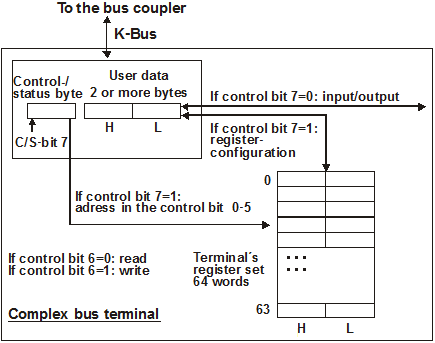Register communication
Register access via process data exchange
- Bit 7=1: Register mode
If bit 7 of the control byte is set, the first two bytes of the user data are not used for process data exchange but written into the register set of the terminal or read from it. - Bit 6=0: read, bit 6=1: write
Bit 6 of the control bytes is used to specify whether a register should be read or written. - Bit 6=0: a register is read without changing it. The value can be found in the input process image.
- Bit 6=1: the user data are written to a register. The process is complete once the status byte in the input process image has returned an acknowledgment (see example).
- Bit 0 to 5: Address
The address of the register to be addressed is entered in bits 0 to 5 of the control byte.
Control byte in register mode (REG=1)
MSB
REG=1 | W/R | A5 | A4 | A3 | A2 | A1 | A0 |
REG = 0bin: Process data exchange
REG = 1bin: Access to register structure
W/R = 0bin: Read register
W/R = 1bin: Write register
A5..A0 = register address
Addresses A5...A0 can be used to address a total of 64 registers.

The control or status byte occupies the lowest address of a logical channel. The corresponding register values are located in the following 2 data bytes. (The BK2000 is an exception: here, an unused data byte is inserted after the control or status byte, and the register value is therefore placed on a word boundary).
Example 1:
Reading of register 8 in the BK2000 with a KL3022 and the end terminal:
If the following bytes are transferred from the controller to the terminal,
Byte | Byte 3 | Byte 2 | Byte 1 | Byte 0 |
Name | Data out, low byte | Data out, high byte | Not used | Control byte |
Value | 0xXX | 0xXX | 0xXX | 0x88 |
the terminal returns the following type identifier (0x0BBA corresponds to unsigned integer 3022).
Byte | Byte 3 | Byte 2 | Byte 1 | Byte 0 |
Name | Data in, low byte | Data in, high byte | Not used | Status byte |
Value | 0xCE | 0x0B | 0x00 | 0x88 |
Example 2:
Write register 31 in the BK2000 with an intelligent and the end terminal:
If the following bytes (code word) are transferred from the controller to the terminal,
Byte | Byte 3 | Byte 2 | Byte 1 | Byte 0 |
Name | Data out, low byte | Data out, high byte | Not used | Control byte |
Value | 0x35 | 0x12 | 0xXX | 0xDF |
The code word is set, and the terminal returns the register address with bit 7 for register access as acknowledgment.
Byte | Byte 3 | Byte 2 | Byte 1 | Byte 0 |
Name | Data in, low byte | Data in, high byte | Not used | Status byte |
Value | 0x00 | 0x00 | 0x00 | 0x9F |